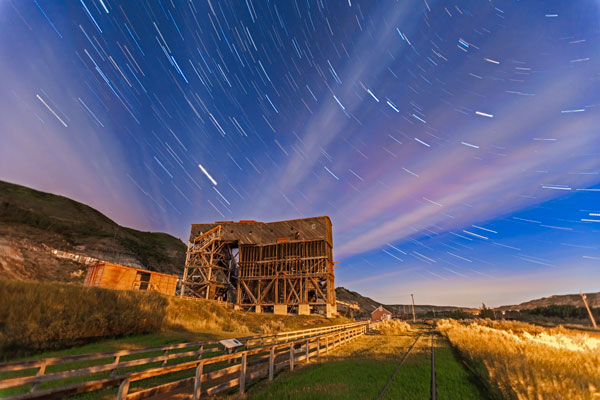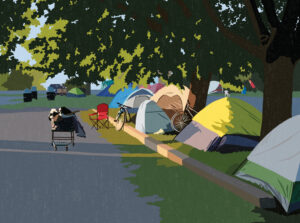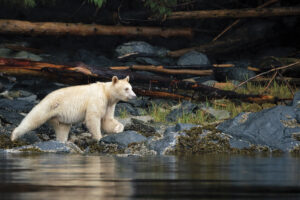
People & Culture
Kahkiihtwaam ee-pee-kiiweehtataahk: Bringing it back home again
The story of how a critically endangered Indigenous language can be saved
- 6310 words
- 26 minutes
This article is over 5 years old and may contain outdated information.
People & Culture

Long after daytime photographers pack up and head home, astrophotographers are settling in under the moon and stars, the only light they need. Alan Dyer has been photographing the night sky since his teens, back in the days of developing film images, and his work has been featured in many places, including National Geographic, The Weather Channel and Spaceweather.com. With the digital equipment that exists today, Dyer says it’s never been a better time to take up astrophotography.
What equipment is necessary for an astrophotographer?
I suggest people start off with just the equipment they have already — a DSLR camera, a sturdy tripod, some sort of remote release to fire the shutter and either the lens that came with your camera or a fast wide-angle lens.
What is the best time of night to shoot?
It depends if you want to use the moon for illumination. When the moon is in its first-quarter phase, it’s generally in the southern sky and lights up landscapes that are to the north and east. A full moon rises at sunset and is in the sky all night long. A last quarter moon won’t rise until after midnight in the east, and will light up landscapes to the west. By knowing when the moon will be at different phases and where it will be in the sky, you can use it as a source of illumination to light up landscapes in a particular direction.

What other sources of light do you use?
The stars themselves become your source of light. DSLR cameras are so sensitive that with a fast, wide-angle lens at F2 or F2.8, you can get shots of the stars over a landscape and there will be details just from the light from the stars. It’s quite impressive. Your exposures have to be long — 30 to 60 seconds — and the ISO speed has to be 1600 to 6400.
What are some tips for photographing the northern lights?
The first challenge is simply getting them to perform and dance for you. If they start happening, they’ll be in the northern sky as a rule. The exposure should be just a few seconds, a fairly fast aperture at F2.8 or F4, and a fairly high ISO speed of 400 to 1600. You can judge from your shots if you need to increase the exposure, or decrease it if it’s a very bright aurora.
How do you capture deep space photos of stars?
You need to attach your camera to a telescope and use a tracking device that turns the camera around Polaris, the North Star, at a rate that equals the speed at which the earth is turning. You can take exposures of several minutes, and the stars won’t streak or trail — they’ll stay as pinpoints as the camera follows the stars.
What if you want to capture star trails?
One way is to simply open up the shutter for many minutes, if not an hour or two. But the more popular method is to take lots of short exposures that might be 20 or 40 seconds long. It’s easier to do that if you have a remote controller that automatically fires your shutter. With only a second or two between exposures, it just goes by itself for as long as you want, an hour or two perhaps, taking what could be hundreds of images. With specialized software or with Photoshop, you take all those images and stack them together to get the equivalent of one exposure made up of hundreds of short exposures. If you aim north, the stars all seem to rotate in circles around the North Star.
How do you capture vibrant colours in your photographs?
The camera always picks up more than what the eye can see because our eyes are not colour sensitive when you get down to very low-light levels. The camera can pick up reds and magentas in the aurora that are tough to see unless the aurora gets really bright. When you do long exposures through a telescope of nebulas, you pick up all kinds of reds, blues and magentas that your eye would never see. Those colours are various wavelengths of light being emitted by glowing gas — oxygen gas glows green, hydrogen gas glows red and blue.
What advice would you give aspiring astrophotographers?
Get out there and start shooting, even from your backyard. You’ll be hooked. Don’t worry about buying fancy gear; get out under the stars with the camera you already have and you’ll be amazed at what you can see and pick up.








Are you passionate about Canadian geography?
You can support Canadian Geographic in 3 ways:

People & Culture
The story of how a critically endangered Indigenous language can be saved

People & Culture
For unhoused residents and those who help them, the pandemic was another wave in a rising tide of challenges

Wildlife
How ‘maas ol, the spirit bear, connects us to the last glacial maximum of the Pacific Northwest

Places
In Banff National Park, Alberta, as in protected areas across the country, managers find it difficult to balance the desire of people to experience wilderness with an imperative to conserve it